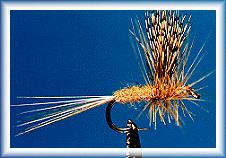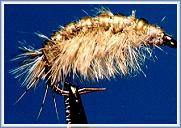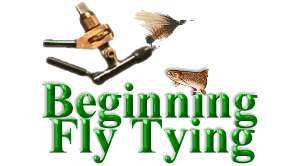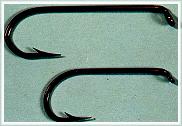It seems strange that I'd start looking at equipment by looking at hooks.
After all, there are many other important things to consider like vises,
bobbins, scissors, etc. to look at.

So why hooks? Well, hooks are the things that hold the feathers, fur,
hair and other fluff you use to create a fly. Hooks are designed for
specific purposes. If you choose the right hook, your fly will be better
proportioned and thus perform better in use. If you choose the wrong hook,
you'll have a flawed fly and your success with that fly will likely be less
than the success you would enjoy with a properly tied fly.
I won't spend a lot of time on barbed vs. barbless hooks. You'll have to
decide the direction to travel there. After all, a simple squeeze from a
small pair of pliers will turn a barbed hook into a barbless one. Rather
than concentrate on hook design, I'd like to spend as much of this time as
possible working toward tying quality flies. However, you'll need to know
what the basic parts and shapes of a hook are if you're going to succeed in
tying your own flies.

Let's take a moment to look at the anatomy of a hook. First, the
hook has a "gape" or gap. That's the distance between the shank
(the part of the hook you tie flies on) and the point. Hook sizes are
usually rated by the size of the gape. Second, the hook has a bend.
Depending on the shape of the bend, it will have different qualities and be
more suitable to certain types of flies. Third, the hook has an eye. The
shape and angle of the eye help determine the possible uses for the hook.
Finally, the hook has a shank. As I mentioned earlier, the shank is the
length of the hook where the body of the fly is usually tied.
There are a lot of companies who make fly tying hooks. Many of their
shapes overlap from company to company. For this reason, I'll usually list
more than one hook for a specific fly. If your favorite hook company has a
similar hook, feel free to use that one instead of the hook I list.

Dry fly hooks come in several shapes and many sizes, just like the
flies. Depending on their use, they might have a straight or a curved
shank.

Some dry fly hooks are longer than others to accommodate the
variables in insect profiles.

Choose your hook according to its use. Many fly tying books
list the appropriate hooks for you, but you aren't bound
to any specific brand as long as the hook has a similar shape,
length and size.

Wet fly hooks are similar to dry fly hooks except they are usually
heavier. Hook bends and shank lengths vary in these hooks depending on
their designed use.

 Nymph hooks vary in design more than any other type.
Some are designed to tie scuds , others lend their
design to stonefly nymphs and some are just good hooks for
common nymphs like mayflies and caddis larva.
Nymph hooks vary in design more than any other type.
Some are designed to tie scuds , others lend their
design to stonefly nymphs and some are just good hooks for
common nymphs like mayflies and caddis larva.


Try to select a nymph hook with a shape similar to the
natural nymph you wish to imitate.

Streamers usually imitate minnows, leaches, crayfish or other swimming
critters. Their hooks are usually longer than the rest and often have
specific bends to accommodate the swimming pattern of the subject being
copied. Some hooks are designed for use in poppers for
bass and panfish. These have a hump in the shank to prevent any turning of
the popper body.
 As you can see, there are a lot of hooks out there.
They each have their designed uses. No one can expect you to have all of
them at first, but a minimum selection of the ones you will use the most is
a good idea.
As you can see, there are a lot of hooks out there.
They each have their designed uses. No one can expect you to have all of
them at first, but a minimum selection of the ones you will use the most is
a good idea.
 Make a list of the flies you really want to tie at first,
then purchase the hooks you need for those flies before you purchase any
others. ~ Al Campbell
Make a list of the flies you really want to tie at first,
then purchase the hooks you need for those flies before you purchase any
others. ~ Al Campbell
Beginning Fly Tying Archives
|




